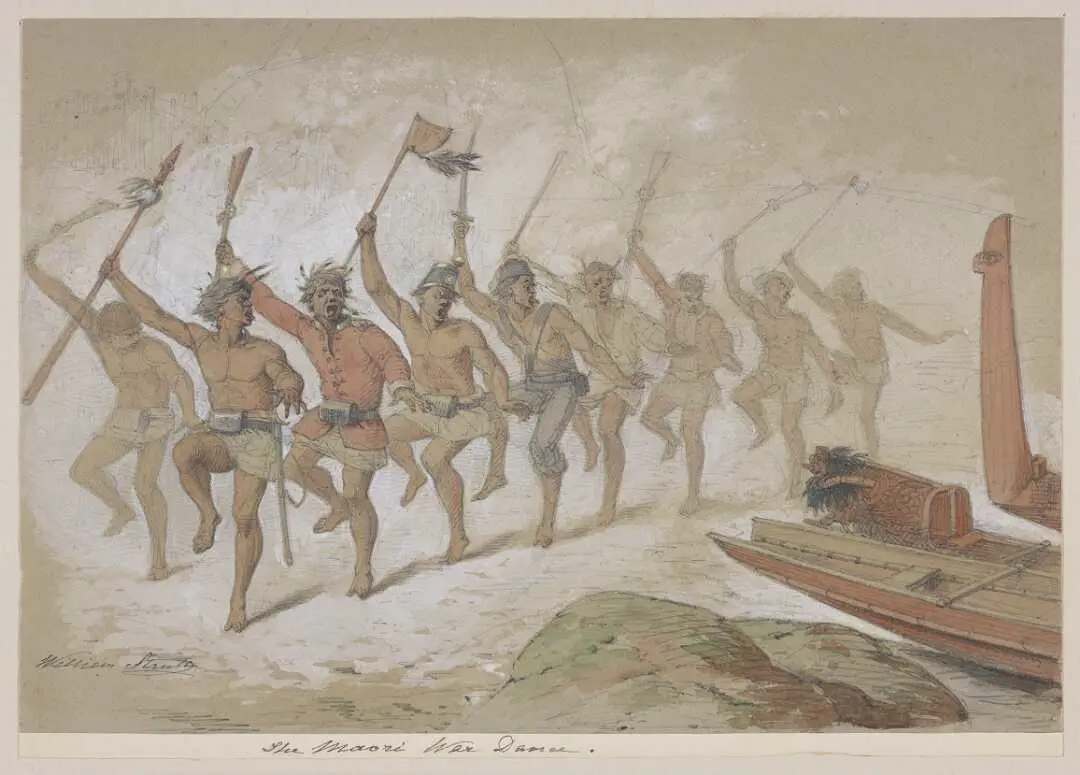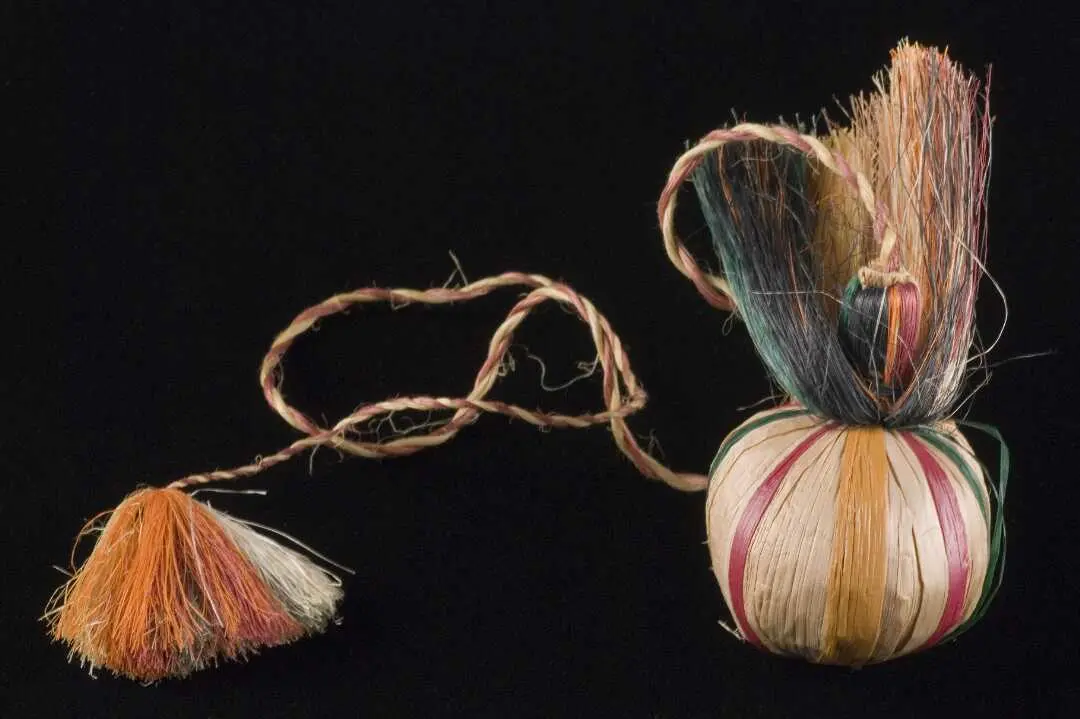
Rhythm and movement
Haka a Tānerore: Me te mea tērā ko te haka a Tānerore, e wiriwiri nei i te raumati | It was as if it was the shimmering of heat haze in the summer – Te Puke ki Hikurangi
Take an audio tour with Paul Diamond one of the curators of Pūkana. Paul shares stories and highlights from the exhibition.
Listen to Paul Diamond talk about ‘Rhythm and movement’ in Pūkana
Transcript — Rhythm and movement
So this section carries on and looks at continuity and change over time. We've got a very early image of men performing a haka by William Strutt from 1855 to 56. So the men are wearing ammunition belts on their waists. They're, sort of, mid-haka. They've got one arm up, all of them. And they're not just holding Māori weapons. They're holding rifles and actually swords, cutlasses and things.
That was interesting once we sort of looked at that sort of mixing of European and Māori items. But then when we put that alongside an image by our colleague, Dylan Owen, Peter Ireland spotted that there were real visual resonances between that struck image and Dylan's image, which is of boys performing haka at Parliament in 2015. And that was when a whole lot of schoolchildren came to Wellington to protest about not being — there not being a national day to commemorate the New Zealand Wars.
And it was fascinating to see those two together, and that was the great thing about working on this exhibition as part of a team is that you got the chance for those sort of connections to be made. Then below those two images and in this part of the exhibition is an image by an artist called John Gilfillan of a woman standing up from a group of men doing haka. So it's a pencil drawing, and the woman has, sort of, come out (from the rest of the group).
Now this might be a thing called manu ngangahu, which is a custom that's in the process of being revived at the moment where the woman comes out of the main group and, sort of, gestures challenges the other group and then she goes back into the main group. That could be what's happening here, but then we put that alongside women in the South Island at the opening of the Tuhuru Meeting House, which I think is in Hokitika. It's on the west coast of the South Island. This is Ngāti Waewae.
Because Ariana who's from Ngāi Tahu, remembered that this had happened, and the women there doing the wero, which is they're practically the only iwi that does this. This is really unusual. And it's a revival, again, of an old custom. So we've put those two alongside each other.
What this section is also looking at is when performance comes out of a Māori setting and goes beyond that into the Pākehā world, into the European world. So we've got Katherine Mansfield's poi that perhaps she collected as a tourist to some part of New Zealand, and we've put that alongside images of the 1978 engineers haka that the next year when that was — this is at Auckland University. Haka over time had become pretty debased and offensive.
The engineers didn't think there was any problem with that, but Māori in the late 70s were very unhappy about that. And a lot of people had asked for it to be stopped. It carried on, and while they were rehearsing there was a big attack by a group who were called He Taua. And there was a big inquiry into race relations. There were court cases.
So we've got those two there to talk about what happens when you take Māori performance out of a Māori setting into different settings. And on the opposite wall in this area, those ideas are really developedm in a section called ‘Whiua ki te ao’, ‘Taking Māori to the world’. And ‘Whiua ki te ao’ comes from a waiata actually called ‘Whakarongo’, which is celebrating Māori language.
And in this section, there are — there's a poster for a performance by a Māori group who were in England and Scotland in the 1860s. And they're probably the first group of Māori performers who came via Melbourne and Sydney and then were taken up to England. And strangely there was another group of Māori in England at exactly the same time.
And they weren't strictly speaking performers. They were taken with a man called William Jenkins who was a lay preacher. And he — he was apparently quite conscious that he didn't want them to be seen as performers, but he was giving illustrated talks about New Zealand and he wanted them to kind of illustrate the talks. So they, kind of, were performers.
His trip was a disaster financially in all sorts of ways. He fell out with the group. They ran out of money. They had to live with in a charitable institution. Two of the people in that group though did meet — when the group met Queen Victoria, two of the group, a husband and wife, Hareata and Hare Pomare, when Hareata was pregnant, Queen Victoria noticed that she was pregnant and, kind of, asked for them to have special treatment. She arranged for their accommodation and was very involved in the — after the birth of their child who was called Albert Victoria after her late husband.
So they had a better time of it, but the rest of the group had a really hard time. Three of them actually left and went to the other group. But below the image of some of the group with William Jenkins, we've got an image of a group of people with a woman who was like the superstar — singing superstar of her day, Princess Te Rangi Pai, who's one of the performers we featured in the Performing Careers section of this exhibition. She's there with Maggie Papakura Makereti, and her sister, Bella, both famous guides from Whakarewarewa from Rotorua.
And they took concert parties to Australia and England, and Princess Te Rangi Pai had a successful career. People may not have heard of her, but they've probably heard of one of the songs that she wrote ‘Hine e hine’ or the Goodnight Kiwi theme, which a song that we still sing which I think is amazing.
We've got these women there to sort of acknowledge that later on Māori had different experiences of taking their perform their performing cultures to the world. And these women had more say over how their performance was taken to the world.
We've got Johnny Cooper's concert poster for a variety show in Greymouth in 1957. When Johnny Cooper was one of the headline acts, he was known as the Māori cowboy. He came down from Wairoa to Wellington. Actually worked as a grave digger while he was, sort of, developing his musical career. Loved country music and recorded New Zealand's, one of the first recordings in New Zealand for rock — the New Zealand version of ‘Rock around the clock’.
But he went on to run talent shows, which in a pre-TV age were hugely important. And it's amazing he went to Māori centres. And there were so many Māori in the photos.
And it's also acknowledging that before he passed away in the early I think it was 2004 he died, he donated and sold his collection to the Turnbull Library. So all through this exhibition we're sort of acknowledging that people who've trusted us with their collections.
Any errors with the transcript, let us know and we will fix them: [digital-services@dia.govt.nz](digital.services@dia.govt.nz?subject=Transcript update&body=Please add the link to the page you are emailing us about.)
Ngā mahi a tānerorore raua ko hineruhi
Ko Tānerore rāua ko Hineruhi ētahi atua e rua o te koringa tinana. Kei tēnei wāhanga o te whakakitenga ngā haka manawataki o te haka me te poi. ‘Ko te haka a Tānerore’ tētahi ingoa mō te kārohirohi, ka kitea atu e kōwiriwiri ana i runga i te papa, i ngā rā wera o te Waru. Ina tū ki te whakakite i te haka i te waiata, ka whakaahua a ngāi Māori i te kārohirohi, he koringa ringa tēnei e mōhiotia nei ko te wiriwiri, hei tohu mō te mauri me te ihi.
He atua a Hineruhi ka puta i te atatū, i roto i te wherikotanga o te tōmairangi o te ata, ā, he atua nāna te haka me te waiata a te wahine. Ina tau te tū a tētahi wahine, ka whakaritea pea ki a ia:
Ko Hineruhi koe, nāna i tū te ata hāpara – Rawinia Higgins rāua ko Arini Loader
Rhythm and movement
Tānerore and Hineruhi are two atua (gods) associated with movement. This section of the exhibition focuses mainly on the rhythmic dances of haka and poi. ‘The dance of Tānerore’ is the haze that shimmers up from the land on a hot day. When performing haka and waiata, Māori emulate this with rapid hand movements, known as wiriwiri, a sign of lifeforce and energy.
Hineruhi is a deity found at dawn whose dance is said to be the sparkle of light that is reflected in the morning dew, and is particularly associated with female performance. When a woman performs with particular finesse, she might be likened to Hineruhi:
You are Hineruhi, the one who brings about the dawn – Rawinia Higgins and Arini Loader
The Maori war dance, 1855 or 1856 by William Strutt. Ref: E-453-f-001. Alexander Turnbull Library.

New Zealand Land wars petition presentation at Parliament. Dylan Owen Ref: PADL-001758. Alexander Turnbull Library.

New Zealand Land wars petition presentation at Parliament. Dylan Owen Ref: PADL-001758. Alexander Turnbull Library.
Raupo long poi, collected by Katherine Mansfield. Ref: Curios-018-1-006. Alexander Turnbull Library.

Feature image at top of page: Visitors exploring the Pūkana exhibition.
